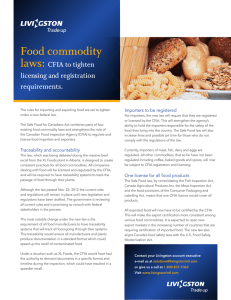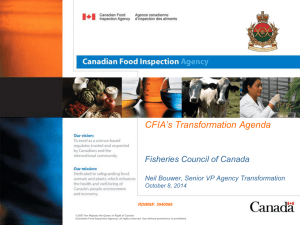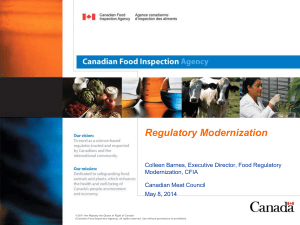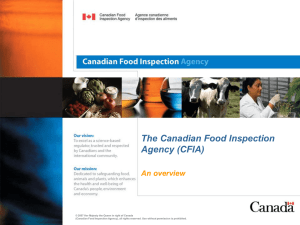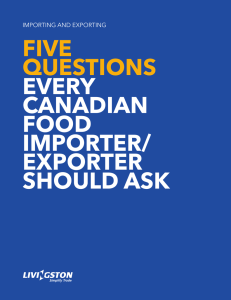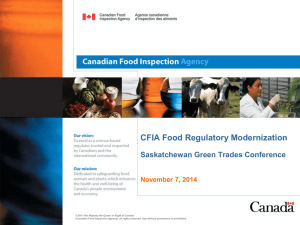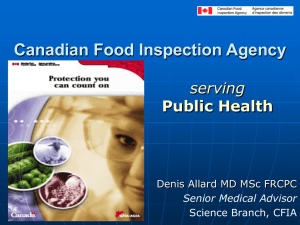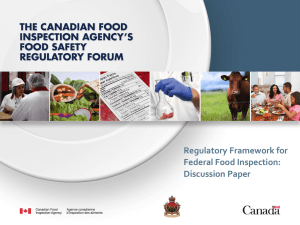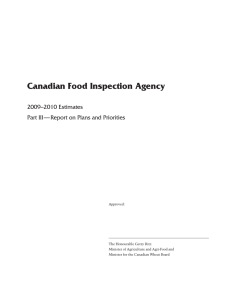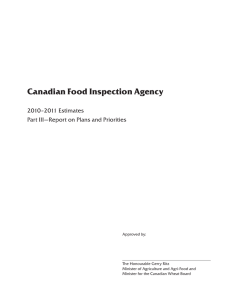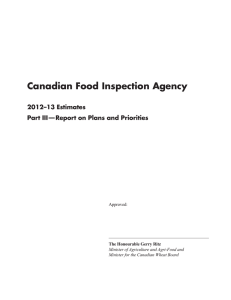Compliance Promotion - the Canadian Health Food Association
advertisement
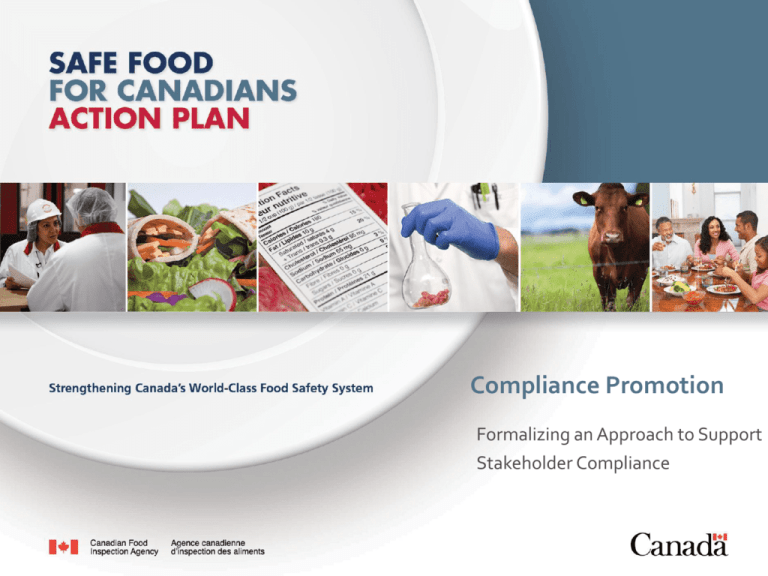
Compliance Promotion Formalizing an Approach to Support Stakeholder Compliance Purpose • To provide an overview of compliance promotion • To discuss how enhanced compliance promotion efforts could improve industry’s ability to meet regulatory requirements • To discuss the role of industry, government and third parties in contributing to an effective compliance management system 2 CFIA Modernization Initiatives • In response to a changing operating environment, the CFIA has embarked on an ambitious transformation agenda • These modernization efforts are being applied to four strategic focus areas: Stronger food safety rules • Legislative/Regulatory Modernization More effective inspection • Inspection Modernization, Inspector Training, Compliance Promotion, Enhanced Science Capacity Commitment to service • Statement of Rights and Service, Service Standards and User Fees More information for consumers • Transparency, Labelling Review 3 4 Background • First step for regulated parties to achieve compliance is for them to understand their obligations and how best to meet them • As the Agency moves towards an improved inspection model and updated regulations for food, information and guidance will be key to success • There are also opportunities for industry, their associations and other interested third parties (e.g. academia, non-government organizations) to play significant role in assisting regulated parties to achieve compliance • Ultimate outcome is that the food safety system is strengthened through better public health outcomes, the generation of efficiencies and the ability to target enforcement efforts Challenges and Barriers to Compliance • There are a variety of challenges and barriers which may impact on industry achieving regulatory compliance: Social Economic Regulatory Principled disagreements with the rules Inadequate financial Difficulty complying with resources or infrastructure overly prescriptive requirements Lack of knowledge or technical specialization Benefits of noncompliance outweighs the cost of compliance Unwillingness to comply Difficulty complying with requirements that are outdated or not in line with modern industry practices Difficulty understanding requirements 5 Challenges and Barriers to Compliance Small Business Constraints: • Small businesses may be particularly challenged to meet regulatory obligations Limitations related to human, financial, technical and time resources Lack of specialized expertise to help them understand and comply with legislative requirements • Generally rely on information provided by the regulator or industry associations 6 Aligning roles and responsibilities • Industry has the responsibility for producing safe food; designing systems to ensure that they meet regulatory requirements • Also provides leadership by promoting best practices, providing peer support and guidance • Third parties (e.g. non-government organizations, academia, food technology centers) have technical expertise and specialized knowledge relevant to their sectors • Can provide services or training tailored to meet industry needs • CFIA communicates regulatory requirements, verifies industry compliance and takes enforcement action where non-compliance identified • Also plays a role in the generation of compliance through communication with regulated parties 7 Why Focus on Facilitating Compliance? • Aligning efforts to support modernization CFIA food safety modernization initiatives require guidance to help regulated parties understand and comply with new requirements • Food Importer Licensing • Inspection Modernization • Outcome-based regulatory approach • Aligning tools for consistency CFIA currently uses a wide variety of tools to promote compliance Issues with respect to inconsistency across commodities and sectors continue to be identified Opportunity to promote consistent compliance and enforcement responses and better facilitate regulated parties’ understanding of legislative requirements 8 Domestic and International Approaches • Innovative approaches are being applied domestically and internationally to achieve and maintain stakeholder compliance: Plain language interpretations (e.g. regulatory requirements) Searchable information (e.g. by business type and by topic) Interactive tools (e.g. templates, checklists, risk assessment tools) Training resources and expert technical advice (e.g. through academic partnerships) Real-time assistance (e.g. hotlines, email, interactive Qs and As) Various methods of dissemination (e.g. podcasts, webinars, print, social media, videos, workshops) Specialized business portals (e.g. focussing on small businesses) 9 Proposed Pillars of a Compliance Promotion Strategy Pillars Examples of Potential Applications Education Enhanced online search function Guidance documents for both stakeholders and CFIA employees Enhanced use of social media Webinars and YouTube videos demonstrations on key topics Technical Assistance Plain language synopses to complement legal documents Training opportunities are provided through partnerships Model systems Searchable question and answer repository Templates, self-assessments and checklists Transparent Communication Industry best practices highlighted as examples Compliance and enforcement data is shared publicly Compliance Incentives Compliance history supports ability to adjust inspection frequencies Support programs conditional on compliance License suspensions and monetary penalties act as deterrents 10 Questions • How could enhanced compliance promotion efforts in the following areas improve industry’s ability to meet regulatory requirements? Education Technical Assistance Transparent Communication Compliance Incentives • What should be the role of industry, government and third parties in contributing to an effective compliance management continuum? • What are the opportunities for collaboration? 11 Feedback Your feedback is welcome • By email: CFIA-Modernisation-ACIA@inspection.gc.ca • By mail: Strategic Partnerships Division 1400 Merivale Road, Tower 1 Floor 6, suite 218 Ottawa, ON K1A 0Y9 Canada Attn: compliance promotion • By fax: 613-773-5606 12
